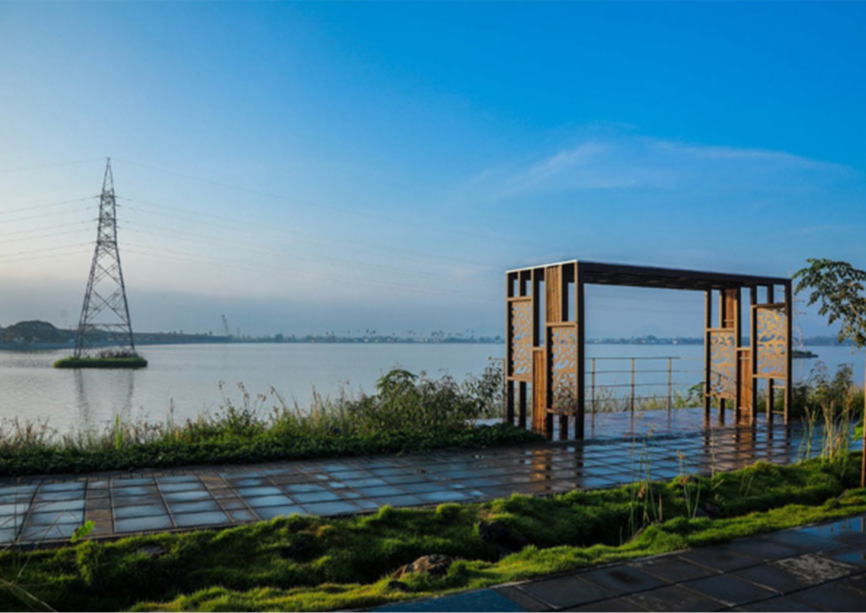-
CENTRES
Progammes & Centres
Location
To reverse the adverse effects of industrialisation and rapid urbanisation on water bodies, India must implement sufficient and sustainable measures to rejuvenate its waterfronts

Image Source: Travel Trade Journal
Throughout history, cities have been closely connected with rivers, which have served as a confluence point for religion, culture, and livelihoods. However, rapid urbanisation and globalisation have transformed Indian cities, resulting in the deterioration of the water bodies and a growing disconnect between the people and such aquatic resources. Another major reason is industrialisation which has polluted waterbodies, making them unsafe for human use. Additionally, dam constructions and overuse of river resources have disrupted traditional local economies and cultures that are dependent on river systems. In recent years, natural habitats and water flow patterns have also been affected by climate change.
Lately, there appears to be a shift in perspective, as cities throughout India are transforming and revitalising their waterfronts to make them accessible to the public. It is aimed at bringing about environmental improvement, social upliftment, and sustainable development. This includes stopping the sewage flow and keeping the river clean and pollution-free, reducing the risk of erosion and flooding, providing public spaces and socio-cultural amenities to attract tourism, generate employment, and ultimately contribute to economic expansion.
Dam constructions and overuse of river resources have disrupted traditional local economies and cultures that are dependent on river systems.
Reconnecting people with rivers is a vital strategy in the realm of environmental conservation and ecology. This concept emphasises the restoration of rivers' natural habitats and the vital ecosystem services they provide. It aims to enhance public awareness and participation in river conservation efforts and advocates for sustainable land use practices that protect and improve river ecosystems. By doing so, it seeks to achieve a range of benefits that include, but are not limited to, improved water quality, increased biodiversity, and expanded recreational opportunities for communities. The positive outcomes of reconnecting rivers with people are manifold. Cleaner water benefits not only the aquatic life that depends on these habitats but also the people who rely on rivers for human use. A richer biodiversity enhances the resilience of ecosystems to environmental changes and challenges. Furthermore, the availability of pristine, natural spaces for outdoor activities enriches the quality of life for individuals and communities alike, promoting physical health and mental well-being through nature-based experiences.
Revitalisation of waterfronts has gained momentum in India. Sabarmati in Gujarat, Chambal in Rajasthan, and Narmada in Madhya Pradesh are some of the major riverfronts that have been revamped and revitalised in recent years. Sabarmati riverfront development project in Ahmedabad was one of the pioneering riverfront development projects launched in the 1990s. In 2021, the Indian government initiated the River Cities Alliance (RCA), a collaborative effort between the Ministry of Jal Shakti (MoJS) and the Ministry of Housing and Urban Affairs (MoHUA) to link river cities and concentrate on sustainable development centred around rivers. Over 142 river cities across India have been identified to develop Urban River Management Plans along with water-sensitive urban designing and planning. In 2023, to further expand the reach of RCA, the Global River Cities Alliance (GRCA), led by the National Mission for Clean Ganga (NMCG) under the Ministry of Jal Shakti was launched at COP28 to create a unique platform for knowledge exchange, river-city twinning, and the dissemination of best practices. Patna Riverfront project, one of the earliest under the NMCG, exemplifies successful urban waterfront development as a collaborative and multifaceted endeavour, simultaneously addressing ecological, environmental, and water-related issues along with infrastructural development. The district administration of Mangalore through Mangalore Smart City Ltd., (MSCL) is executing the Netravathi Riverfront project which seeks to reconnect people with the riverfront through the development of dynamic spaces such as the 2.2 km pedestrian path, biodiversity park, and patches of mangrove.
Patna Riverfront project, one of the earliest under the NMCG, exemplifies successful urban waterfront development as a collaborative and multifaceted endeavour, simultaneously addressing ecological, environmental, and water-related issues along with infrastructural development.
While the redevelopment of waterfronts can lead to fruitful outcomes for the city; it is imperative to evaluate the approach and consider potential challenges to ensure the sustainability of these waterfronts. There are various ways in which waterfront projects can leverage the value of the urban blue-green asset for the city and its people.
Mixed-use development approach not only diversifies the use of the area but also injects life into it, all while preserving and celebrating its heritage and history. In India, Sabarmati Riverfront is another example of mixed-use development which revitalised the once neglected and polluted waterfront into a thriving space boasting parks, gardens, walkways, haats (commercial spaces), etc. The continuous pedestrian pathways along the Chandi Ghat at the Patna Riverfront Development have been key in creating inclusive spaces. These walkways facilitate a range of socioeconomic activities and effectively connect people to these revitalised urban spaces.
Engaging a diverse range of participants and organizations including local government, planning and development agencies, city leaders, and community members through innovative, multi-stakeholder collaboration is crucial for inclusive and dynamic waterfront development. For example, the Kota Chambal Riverfront Restoration project, witnessed 27 theme-based ghats, each highlighting a facet of Indian cultural heritage developed by the Urban Improvement Trust (UIT) with strong local support from city leaders. Prevention of displacement and if displaced, proper rehabilitation of displaced communities must be paramount. The establishment of interdepartmental entities, such as special purpose vehicles or rehabilitation/waterbody improvement trusts/groups, can further enhance the coordination and cooperation among different stakeholders. Sabarmati Riverfront Development Corporation Limited was launched by Ahmedabad Municipal Corporation in 1997 as a Special Purpose Vehicle (SPV) to redefine the identity of Ahmedabad around the river and reconnect the city with the river while positively transforming the riverfront.
The development of urban waterfronts should prioritise nature and ecology and beautification and redevelopment should not come at an environmental cost. The creation of public spaces should be closely aligned with environmental restoration efforts, mirroring the approach taken with the Godavari riverfront in Nashik, where the river was desilted to reduce flood risk and de-concretised by removing many structures that were built over the years. Projects should aim for low-impact and resilient design to help adapt to any future climate vulnerabilities like Lake, one of the seven old lakes revived under Coimbatore’s Smart City Project which has integrated green infrastructure into waterfront development. A balanced approach prioritising environmental concerns alongside beautification would ensure the development of sustainable waterfronts.
The creation of public spaces should be closely aligned with environmental restoration efforts, mirroring the approach taken with the Godavari riverfront in Nashik, where the river was desilted to reduce flood risk and de-concretised by removing many structures that were built over the years.
The economic viability of urban waterfront projects lies in the identification of various revenue streams. In India, Coimbatore has revitalised the Valankulam lakefront, transforming a landfill into a vibrant space consisting of sources of revenue generation like exhibition areas, co-working spaces and restaurants. The development of a 3.3-kilometre riverfront along the Kahn River in Indore has led to a significant 40 percent increase in local property prices, indirectly boosting the city's economy by stimulating local businesses and tourism. The integration of commercial spaces is important, as a waterfront becomes self-sustainable, ensuring its long-term viability.
To conclude, since waterfronts often represent the most appealing and dynamic areas within cities and command the highest return on investment worldwide, it is imperative to unlock their full potential. Adopting a strategic vision that encapsulates the collective interests of the community and an organic, step-by-step transformation, responsive to the evolving requirements of both the city and its people, is crucial. This approach not only guides the development process but also ensures that the revitalisation of the urban waterfront is credible and sustainable. Therefore, strategies should prioritise environmental sensitivity, social inclusivity, equitable outcomes, and adaptability to climate change.
Adopting a strategic vision that encapsulates the collective interests of the community and an organic, step-by-step transformation, responsive to the evolving requirements of both the city and its people, is crucial.
Maintaining completed riverfront development projects is crucial for ensuring their longevity, enhancing the quality of life for the surrounding communities, and preserving the natural environment. Effective maintenance requires a combination of good management practices, from physical upkeep to community engagement and environmental management. Such activities can include regular cleaning, landscaping and green space care, infrastructure repair and upkeep, water quality monitoring, vegetation and wildlife protection and erosion control.
Education and awareness campaigns can play a key role in fostering a culture of respect and responsibility towards the riverfront and changing people's habits and attitudes towards protecting the environment. This can include encouraging people to reduce, reuse, recycle; community involvement through volunteer clean-up events; promotion of sustainable transportation to reduce pollution and congestion, etc. Additionally, incorporating sustainable design elements in the development phase can reduce maintenance needs and environmental impact over time.
Arjun Dubey is a Research Associate at the Institute for Human Development
Aditi Madan is a Fellow at the Institute for Human Development
The views expressed above belong to the author(s). ORF research and analyses now available on Telegram! Click here to access our curated content — blogs, longforms and interviews.

Arjun Dubey is a Research Associate at the Institute for Human Development. He did his post-graduation in Development Studies from Ambedkar University, Delhi. His areas ...
Read More +
Dr. Aditi Madan is Fellow and an ICSSR post-doctoral fellow at Institute for Human Development (IHD) with a PhD in Disaster Management from Asian Institute ...
Read More +